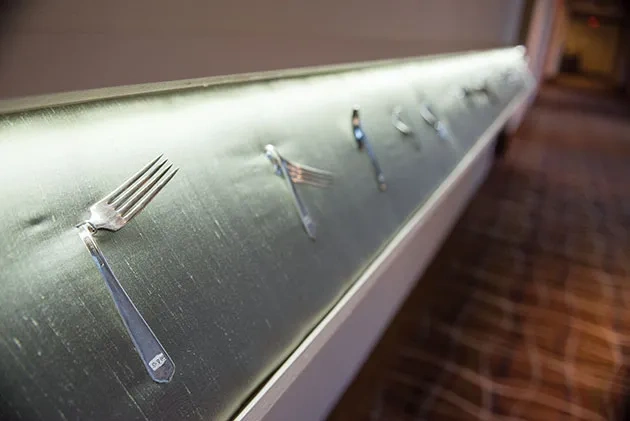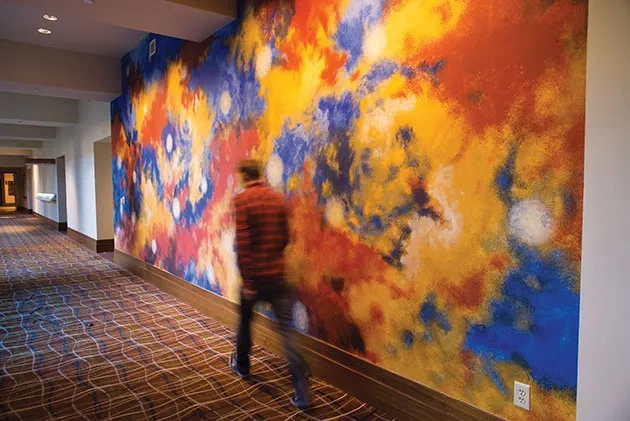The Dark Arts
From spoon-bending to séances, an art professor finds inspiration beyond the grave.


Something strange happened in a UT art class a few years ago. Professor John “Jack” Stoney and his students switched off the lights, lit a few candles, and spread tablecloths across the desks. They set up a revolving door—the black, sarcophagus-shaped kind used to seal light out of darkrooms—at the entrance and called it a portal. Stoney walked around the room, passing out forks and spoons. He took one for himself, too. Then everyone took their seats, picked up a piece of silverware, and began shouting, “Bend! Bend! Bend!”
This wasn’t witchcraft or wizardry, but instead something only slightly less absurd: a spoon-bending party. Spoon-bending is a paranormal parlor trick in the tradition of table-tilting and the Oujia board, which date back to the 1800s. The idea that you could bend a spoon using only your mind was popularized in the 1970s by magician Uri Geller, although college students these days are more likely to recognize it from a brief, inscrutable scene in The Matrix. The basic premise hasn’t changed over the centuries. A group of people gather to hold, stroke, and yes, talk to spoons in the hope that they will bend seemingly on their own. “After five minutes of this, it gets really boring,” Stoney recounts. “But eventually, someone is momentarily distracted, and then ... ” He lets his hand droop, mimicking warm metal. “It happens to no more than 15 percent of the people, and as soon as you realize it, you feel the spoon stiffen up again. It’s a very odd, amazing experience.”

The misshapen silverware formed part of an exhibit Stoney created for UT’s Courtyard Gallery, Medium. The gallery itself is easy to miss—it’s a small hallway tucked away in the AT&T Conference Center—but for Stoney, process matters as much as product. He traces his interest in parapsychology back to his childhood in Houston, where his father, a NASA engineer by day, regularly held spoon-bending parties and séances at their home. “My dad had this hobby his whole life, but I didn’t pay much attention until recently,” Stoney says. “I don’t believe this stuff is real, but what it is is just as interesting.” As for spoon-bending, he says, “It’s relevant because it’s sculpture! Sculpture is all about the manipulation of materials, and that’s what this is.”

Stoney’s interest in parapsychology isn’t limited to spoon-bending. He’s also created paintings and wall drawings based on his experiences as a participant in séances. Stoney recorded the instructions over two visits to professional mediums in Lily Dale, New York—a historic town known as the capital of the Spiritualist movement. During these sessions, Stoney joined several strangers, each of whom asked the medium to contact a dead person. He wanted to talk to one of his heroes, the late artist Sol LeWitt, whose conceptual sculptures and wall drawings pushed the boundaries of what art could be from the 1960s until his death in 2007.
Making art based on a psychic’s channeling of a dead artist may sound distasteful, but LeWitt probably would’ve liked the idea. Many of his own works were created entirely by assistants working from detailed instructions. While some critics scoffed at an artist who could create masterpieces without ever touching them, LeWitt saw himself as a bit like an architect handing over blueprints to a carpenter. “The idea itself, even if not made visual, is as much a work of art as any finished product,” he famously said.
And as Stoney points out, art is all about inheriting and translating ideas: “Dead artists have been ‘speaking’ through other artists for all of history,” he says—even if they don’t usually do it quite so literally.
Photos from top:
Photos by Anna Donlan
An untitled work created with cutlery transformed by a spoon-bending session; Sandy Carson
"After LeWitt #3," a painting Stoney's students created based on instructions from a medium, who described "an overwhelming mass of color, vivid yet calming;" Sandy Carson






